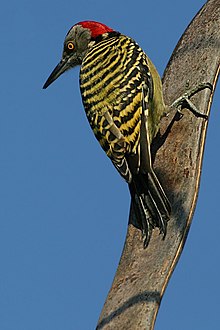Picinae
| Woodpeckers | |
|---|---|
 |
|
| Hispaniolan woodpecker | |
| Scientific classification | |
| Kingdom: | Animalia |
| Phylum: | Chordata |
| Class: | Aves |
| Order: | Piciformes |
| Family: | Picidae |
| Subfamily: |
Picinae Bonaparte 1838 |
| Genera | |
|
Several, see text. |
|
Several, see text.
Woodpeckers are near passerine birds of the order Piciformes. They are one subfamily in the family Picidae, which also includes the piculets and wrynecks. They are found worldwide and include about 180 species.
Woodpeckers gained their English name because of the habit of some species of tapping and pecking noisily on tree trunks with their beaks and heads. This is both a means of communication to signal possession of territory to their rivals, and a method of locating and accessing insect larvae found under the bark or in long winding tunnels in the tree or upright log.
Some woodpeckers and wrynecks in the order Piciformes have zygodactyl feet, with two toes pointing forward, and two backward. These feet, though adapted for clinging to a vertical surface, can be used for grasping or perching. Several species have only three toes. The woodpecker's long tongue, in many cases as long as the woodpecker itself, can be darted forward to capture insects. The tongue is not attached to the woodpecker's head in the same way as it is in most birds, but instead it curls back up around its skull, which allows it to be so long.
The woodpecker first locates a by tapping on the trunk with its head. Once a tunnel is found, the woodpecker chisels out wood until it makes an opening into the tunnel. Then it worms its tongue into the tunnel to try to locate the grub. The tongue of the woodpecker is long and ends in a barb. With its tongue the woodpecker skewers the grub and draws it out of the trunk.
Woodpeckers also use their beaks to create larger holes for their nests which are 15–45 cm (6–18 inches) below the opening. These nests are lined only with wood chips and hold 2–8 white eggs. Because the nests are out of sight, they are not visible to predators and eggs do not need to be camouflaged. Cavities created by woodpeckers are also reused as nests by other birds, such as grackles, starlings, some ducks and owls, and mammals, such as tree squirrels.
...
Wikipedia
